Oxford
Explore hidden histories, historic photos, and things you never knew about Oxford from the collections and archives of Historic England.
Discover your local listed buildings and places
Introducing some of Oxford's most historic sites, included in the National Heritage List for England. Some of these captions have been summarised by AI. Click through for the official List entry. Skip this section and go to place by numbers
Minchery Farmhouse
Littlemore
Minchery Farmhouse is a 15th-century structure, reconstructed around 1600, featuring significant architectural elements like stone-mullioned windows and a 17th-century staircase with Tudor...
Bodleian Library and Schools Quadrangle Including the Div…
Oxford
The Bodleian Library and Schools Quadrangle, including the Divinity School and Convocation House, is a central and historically important group of buildings in Oxford, dating from 1424-1924.
Headington Hill Hall and attached forecourt wall
Oxford
Headington Hill Hall, built by John Thomas for brewer James Morrell in the 1850s, features a varied Italianate style with significant interior remodeling by architect William Wilkinson.
Sir Thomas White Building, St John's College
Oxford
Student accommodation and common rooms, designed 1967-70 by Philip Dowson of Arup Associates, built 1972-5.
Hilda Besse Building Including Stepped Plinth and Paved A…
Oxford
Hall and common rooms, with kitchen facilities, in a free-standing block. It was commissioned as part of a larger scheme in 1960; final design 1966; built 1967-71.
The Nuffield Institute For Medical Research the Radcliffe…
Oxford
The Radcliffe Observatory, now the Nuffield Institute for Medical Research, was designed by Henry Keene and completed by James Wyatt.
Landscape at St Catherine's College
Oxford
Mid-1960s college buildings with contemporary gardens and quadrangle, the whole by Arne Jacobsen (1902-1971).
24-37, Beaumont Street
Oxford
Beaumont Street features a terrace-type scheme from 1828-37, constructed with Bath stone fronts and distinctive architectural elements such as mansard roofs and iron balconies.
Church of St Philip and St James
Oxford
The Church of St Philip and St James, designed by G.E. Street in 1862, is a prominent Victorian church with a notable broach spire and elaborate granite nave piers.
The University Museum and Pitt Rivers Museum
Oxford
The University Museum and Pitt Rivers Museum is a significant mid-late 19th-century complex showcasing innovative design influenced by John Ruskin, housing extensive scientific collections...
Radcliffe Camera
Oxford
Radcliffe Camera, built in 1737-49 in Oxford by James Gibbs, is a historic building of great importance funded by Dr. John Radcliffe.
Worcester College
Oxford
Worcester College, established in 1714, features buildings from the 15th, 18th, and 20th centuries, picturesque 19th-century gardens, and a lake, reflecting its diverse architectural and...
Trinity College
Oxford
Founded in 1555, Trinity College in Oxford showcases historical architecture influenced by Sir Christopher Wren and features expansive quads and gardens, retaining its historical development...
Oxford Castle and earlier settlement remains
Oxford
Oxford Castle, a motte and bailey castle built in 1071 by Robert d'Oilly, is notable for its historical significance in Norman Britain and Oxford's development.
Oxford Botanic Garden
Oxford
Oxford Botanic Garden, established in the 17th century by Henry Danvers, features historic walls and paths, serving as an educational facility with a rich botanical collection.
Ruskin College (1913 building)
Oxford
Working men's college, designed 1907 by Joseph and Smithem, built (though never completed) 1912-13.
The Rhodes Building (North Range) , Oriel College
Oxford
The Rhodes Building forms the north range of St Mary's (or 'the Third') Quadrangle at Oriel College and was built to house undergraduates and Fellows of the college.
Pembroke College, North Range Including Library and North…
Oxford
Pembroke College's North Range, built in 1673, includes a library with historical elements from Broadgates Hall and features 19th-century remodeling by Daniel Evans.
Church of St Giles
Oxford
The Church of St Giles is a parish church with a late 12th-century west tower, early 13th-century chancel, and various restorations from the 19th and 20th centuries.
Section of the Grandpont causeway
Oxford
The Grandpont causeway, originating from the Saxon or early Norman period, is a significant archaeological feature in Oxford, showcasing medieval road construction beneath modern roads with...
Church of St Mary Magdalen
Oxford
The Church of St Mary Magdalen is a parish church with architectural elements dating back to the late 13th century, featuring restorations and additions through the 19th century.
New College Oxford, Cloister (to West of Chapel)
Oxford
The cloister at New College, Oxford, built between 1395 and 1400 in Wheatley stone, features eight medieval stone figures originally from the Chapel.
Worcester College, North Range
Oxford
The North Range at Worcester College features 15th-century structures converted into a Senior Common Room. Additions and alterations occurred in the 18th and 20th centuries.
The Sheldonian Theatre
Oxford
The Sheldonian Theatre, built in 1664-69, features design by Wren, stonework from Headington, and ceiling by Robert Streater, showcasing early English illusionist decoration.
The Ashmolean Museum and the Taylor Institute
Oxford
The Ashmolean Museum and the Taylor Institute, located at St Giles's Street, was designed in Neo-Greek style by Charles Robert Cockerell and built between 1841-45.
Campion Hall (Including Chapel) Micklen Hall (Including C…
Oxford
Campion Hall, designed by Sir Edwin Lutyens in 1934-6, integrates parts of a 17th-century house and features a chapel, creating a historic and architectural blend.
Park Town
Oxford
Park Town was developed in mid-19th century Oxford by architect Samuel Lipscombe Seckham and landscaper William Baxter, featuring communal gardens and villas for varied income groups.
Church of St Aloysius (Roman Catholic)
Oxford
The Roman Catholic Church of St Aloysius, built in 1875 with Joseph Hansom as architect.
The University Printing House (The Clarendon Press)
Oxford
The University Printing House, designed in the 19th century by Daniel Robertson and Edward Blore, features Corinthian elements and has undergone alterations over time.
County Hall With the Curving Screen Walls and Turrets on …
Oxford
The County Hall is a striking 1841 Neo-Norman fortress designed by J Plownan, featuring Georgian windows, a castellated porch, and decorative mock arrow slits.
Corpus Christi College, Hall
Oxford
Corpus Christi College Hall, originally from 1485, features an original roof and was repanelled in 1700 by Arthur Progley, with carvings by Jonathan Mayn.
Stones Almshouses (8 Tenements)
Oxford
Stones Almshouses, founded in 1700 by William Stone, feature eight tenements with elm architecture, notable for its stone framed doorway and dormers. Major restoration occurred in 1958.
126, High Street
Oxford
126 High Street in Oxford is a notable 15th-century timber-framed building with a distinctive late 17th-century facade, featuring original glazing and medieval cellars.
Worcester College, Gateway on Walton Street to the North …
Oxford
Worcester College's 15th-century gateway on Walton Street features shields of the Abbeys of Winchcombe, St Albans, and Ramsey, highlighting its historical significance.
Wall at Holy Rood Roman Catholic Church
Oxford
A section of north-south aligned wall, C18 with C19-C20 repairs and capping (part of the rear boundary wall of Grandpont House) which continues along Abingdon Road (east-side).
C Wing Including the Round Tower
Oxford
C Wing, including the Round Tower at HM Prison Oxford, is a significant historical structure dating back to 1785 by William Blackburn, featuring early prison cells.
Explore more
Search for more listed placesOxford through time
This timeline shows the first period of use for buildings and places on the National Heritage List for England, just one of the details recorded for every list entry. Click around to see how Oxford changes over time. Skip this section and go to aerial photos
Early medieval AD 410 to AD 1066
This period, often associated in England with Anglo-Saxons and Vikings, saw a reduction in urban living from the Roman period and increased migration from northern Europe.
Traces of this period can be found in cemeteries, particularly in artefacts and in some of the very early churches, as this period also saw the growth of Christianity in Britain.
Medieval AD 1066 to AD 1540
This period, sometimes known as the Middle Ages, began with the Norman invasion in AD 1066. It saw a significant rise in military and defensive buildings such as castles and earthworks, as well as religious houses dominating a largely agricultural landscape.
The monarchy and Church dominated the period, which also saw the break with the Roman Catholic Church and the English reformation.
Post medieval AD 1540 to AD 1901
The Post-Medieval period brought seismic changes to life in England, with religious reformation leading to the democratization of worship and the destruction of hundreds of religious houses.
In parallel, there was a huge expansion of scientific study and enlightenment that permanently altered the nation's social structure and landscape. Industrialization and mass production lead to wider global trade, emigration, and immigration.
20th century AD 1901 to AD 2000
The 20th century saw an incredible expansion of England's transport networks, with suburban growth shadowing rapid infrastructural expansion. The establishment of state schools, hospitals, and modern technical colleges, with new architectural styles, radically changed the appearance of towns and cities.
Two catastrophic world wars and the 1918 pandemic also brought unprecedented change, altering England's built environment and social structures forever.
Early medieval AD 410 to AD 1066
This period, often associated in England with Anglo-Saxons and Vikings, saw a reduction in urban living from the Roman period and increased migration from northern Europe.
Traces of this period can be found in cemeteries, particularly in artefacts and in some of the very early churches, as this period also saw the growth of Christianity in Britain.
Medieval AD 1066 to AD 1540
This period, sometimes known as the Middle Ages, began with the Norman invasion in AD 1066. It saw a significant rise in military and defensive buildings such as castles and earthworks, as well as religious houses dominating a largely agricultural landscape.
The monarchy and Church dominated the period, which also saw the break with the Roman Catholic Church and the English reformation.
Post medieval AD 1540 to AD 1901
The Post-Medieval period brought seismic changes to life in England, with religious reformation leading to the democratization of worship and the destruction of hundreds of religious houses.
In parallel, there was a huge expansion of scientific study and enlightenment that permanently altered the nation's social structure and landscape. Industrialization and mass production lead to wider global trade, emigration, and immigration.
20th century AD 1901 to AD 2000
The 20th century saw an incredible expansion of England's transport networks, with suburban growth shadowing rapid infrastructural expansion. The establishment of state schools, hospitals, and modern technical colleges, with new architectural styles, radically changed the appearance of towns and cities.
Two catastrophic world wars and the 1918 pandemic also brought unprecedented change, altering England's built environment and social structures forever.
Aerial photos of Oxford
Aerial photography helps reveal secrets of England's changing landscapes that are impossible to see from the ground. Skip this section and go to archive images
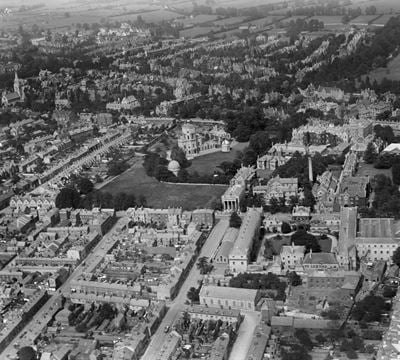
Oxford
The Radcliffe Observatory, Oxford, 1920

Oxford
The Radcliffe Observatory, Oxford, 1951
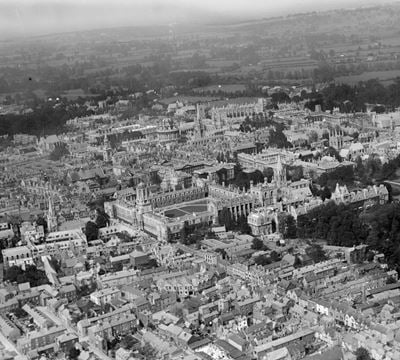
Oxford
General view over Oxford showing Christ Church and Radcliffe Camera, Oxford, 1920

Oxford
High Street and the city centre, Oxford, 1953
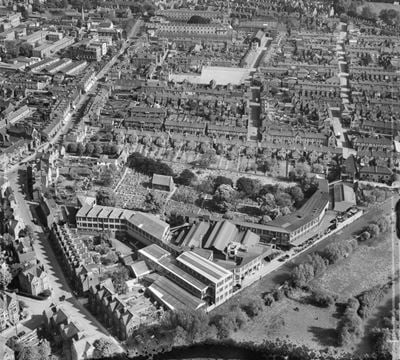
Oxford
The Eagle Ironworks, St Sepulchre's Cemetery and Jericho, Oxford, 1952

Oxford
The Eagle Ironworks, St Sepulchre's Cemetery and Jericho, Oxford, 1952
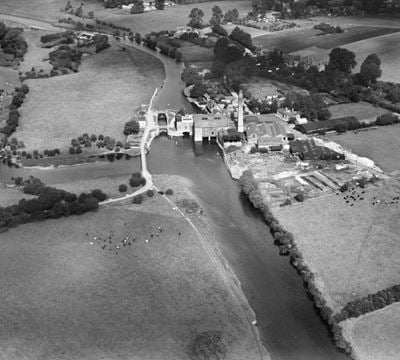
Sandford-On-Thames
The Cannon and Clapperton Paper Mill, Sandford-on-Thames, 1928

Sandford-On-Thames
The Cannon and Clapperton Paper Mill and Sandford Lock, Sandford-on-Thames, 1928
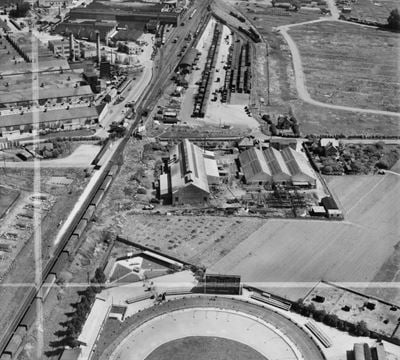
Cowley
The Oxford & Cowley Ironworks Ltd, Cowley, 1950
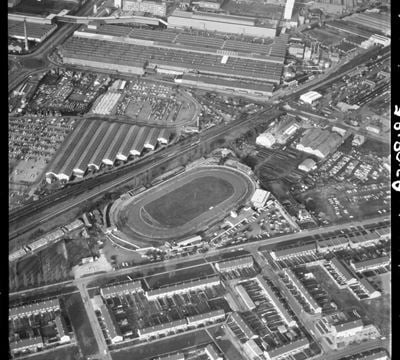
Oxford Stadium
Oxford Stadium, a greyhound racing track, Oxford, 1971
Oxford in the Historic England Archive
The Historic England Archive cares for over 15 million images, dating from the 1850s to the present day. Discover stunning images of Oxford's past. Skip this section and go to stories about heritage
Eric de Mare
Iffley, Oxford, Oxford, Oxfordshire
Date created: 1945 - 1980
Exterior detail view of St Mary's Church in Iffley showing a highly decorated door surround.
John Gay Collection: Rural Life
Oxford, Oxfordshire
Date created: Jul 1959
A tractor mounted aloft on the Massey-Ferguson stand at the Royal Show
John Gay Collection: Counties
Oxford, Oxfordshire
Date created: Jul 1959
Two Indian Runner Ducks peer at each other at the Royal Show, Oxford
John Laing Collection
Oxford, Oxfordshire
Date created: Jun 1963
View of Evenlode Tower 'Storiform' flats at Blackbird Leys in Oxford with Windrush Tower visible in the background
London, Midland and Scottish Railway Company
Iffley, Oxford, Oxford, Oxfordshire
Date created: circa 1898
The west front of St Mary's Church
Nigel Temple Collection of Postcards of Parks and Gardens
Oxford, Oxfordshire
Date created: 1900 - 1930
GENERAL VIEW ALONG RIVER LOOKING TOWARDS MAGDALEN COLLEGE AND BRIDGE
Margaret Tomlinson Collection
Oxford, Oxfordshire
Date created: 01 Jan 1943 - 20 Apr 1943
The exterior of numbers 79-84 St Aldate's with the premises of Charles Raworth & Son (79-80) in the foreground
Walter Scott
Oxford, Oxfordshire
Date created: 1930 - 1950
A view of college barges on the River Thames near Folly Bridge, Oxford
John Gay Collection: Counties
Oxford, Oxfordshire
Date created: Jul 1959
A view showing a handkerchief tied to the aerial of a car in a full car park at the Royal Show, Oxford
John Laing Collection
Oxford, Oxfordshire
Date created: 09 Apr 1962
Looking up from ground level at the 15-storeys of flats at Windrush Tower in Blackbird Leys
London, Midland and Scottish Railway Company
Iffley, Oxford, Oxford, Oxfordshire
Date created: circa 1898
The exterior of the Norman west doorway at St Mary's Church
Stories about heritage in your local area
Historic England publishes news, blogs, research, videos, and podcasts celebrating England's rich heritage. Discover the stories we have about Oxford. Skip this section and go to education
What Was the Capital of England Before London?
Mentions Bodleian Library and Schools Quadrangle Including the Divinity School and the Convocation House
London is England’s capital city now, but when was it founded? And what was the capital of England before London?
Groundbreaking English Women of Science
Mentions Inorganic Chemistry Laboratory (Old Chemistry Department), Somerville College, Walton House
Discover the lives of women who impacted scientific discoveries in England's history, such as Marie Stopes and codebreaker Joan Clarke.
Who Was the First King of England?
Athelstan (or Æthelstan), the Anglo-Saxon ruler, is considered the first King of England, who reigned from AD 924 to 939.
The Life, Love and Legacy of Feminist Pioneer Rose Sidgwick
Mentions Somerville College, Library
Unpick the legacy of the historian who made pioneering contributions to history and international feminism.
What Is the Oldest House in England?
Mentions Frewin Hall
Discover when the oldest house in England was built. The earliest domestic house, Saltford Manor House, could date from the 12th century.
16 Historic Gardens and Landscapes to Visit
Mentions Oxford Botanic Garden
Try these English gardens if you’re looking for somewhere with spectacular garden scenery.
8 Sites of Scientific Discovery and Innovation
Mentions Somerville College, Hall and Maltland Block
From Charles Darwin to Alan Turing, discover incredible places in England connected to scientific achievement.
A Brief Introduction to Christopher Wren
Mentions The Sheldonian Theatre
Christopher Wren was a polymath, scientist and world-renowned architect.
10 Historic Sites That Tell the Story of Katherine of Aragon in England
Mentions Cathedral Church
Explore the significance of places visited or lived in by Katherine of Aragon, the first wife of Henry VIII.
10 Accessible Historic Places to Visit
Mentions The University Museum and Pitt Rivers Museum
Here we look at some listed places that have creatively improved their accessibility.
The History of the English Science Lab
Mentions The Ashmolean Museum and the Taylor Institute, 106 and 107, High Street
The modern laboratory emerged in the 1680s when the University of Oxford built the first Ashmolean Museum.
Women Architects Who Helped Shape England
Mentions The Garden Building at St Hildas College
Women have always influenced domestic design but it wasn’t until 1898 that the first female architect was admitted to the Royal Institute of British...
Cambridge University’s Darwin College Protected
Mentions St Annes College, Wolfson and Rayne Buildings
The Dining Hall and the Rayne Building at Darwin College, Cambridge have been listed at Grade II.
The Best of England’s Post-War Parks, Gardens and Landscapes Protected
Mentions Landscape at St Catherine's College
Newly announced protections by Historic England are the result of a three-year collaboration with The Gardens Trust.
National Collection of Sir Herbert Baker’s War Memorials Recognised
Mentions Rhodes House
15 First World War memorials by Sir Herbert Baker have been listed or upgraded to commemorate the centenary of the Commonwealth War Graves Commission.
Groundbreaking Women of Science Celebrated
Mentions Somerville College, Walton House, 62, Banbury Road
Historic England and The Royal Society celebrate International Women’s Day by bringing to light the exceptional achievements of female scientists
National Collection of Lutyens’ War Memorials Listed
Mentions Oxfordshire and Buckinghamshire Light Infantry War Memorial
All 44 First World War memorials designed by Sir Edwin Lutyens are now protected by listing.
Oxford's social history through photos
Over 10,000 images from the Historic England Archive have been specially selected and re-captioned for teachers, students, and anyone who wants to learn more about their local area. Skip this section and go to grant-aided places
Well House (Conduit House), North Hinksey, Oxfordshire
Period: Stuart (1603 - 1713)
This Well House was built in c1610. It was built for Otho Nicholson.
Well House (Conduit House), North Hinksey, Oxfordshire
Warneford Asylum, Oxford, Oxfordshire
Period: Victorian (1837 - 1901)
Looking from the north toward the front of the hospital, then known as Warneford Asylum and founded in 1826.
Viewing X-Rays, St Hugh's Military Hospital (Head Injuries), St Margaret's Road, Oxford, Oxfordshire
Period: World War Two (1939 - 1945)
Medical staff viewing encephalograms (x-rays) of head injuries.
Viewing X-Rays, St Hugh's Military Hospital (Head Injuries), St Margaret's Road, Oxford, Oxfordshire
Victoria Fountain, The Plain, Oxford, Oxfordshire
Period: Victorian (1837 - 1901)
The opening of the new drinking fountain and clock tower, built by E P Warren in 1899.
Thurstons Colormatography, Oxford, Oxfordshire
Period: Edwardian (1902 - 1913)
A large crowd gathered in the street outside the attraction during St Giles' Fair. The fair was an annual event held at the beginning of September.
Thurstons Colormatography, Oxford, Oxfordshire
The Old Clarendon Building, Oxford, Oxfordshire
Period: Stuart (1603 - 1713)
The architect Nicholas Hawksmoor's first building in Oxford was a new University printing house (now known at the Clarendon Building).
The Old Clarendon Building, Oxford, Oxfordshire
The Chequers, Headington, Oxford, Oxfordshire
Period: Victorian (1837 - 1901)
The Headington Quarry Morris Men outside the Chequers pub with a fiddle player at the centre.
Taunts Shop, 9-10 Broad Street, Oxford, Oxfordshire
Period: Victorian (1837 - 1901)
Henry Taunt's shop in the street, which he leased in 1874 after moving from Cornmarket Street.
Taunts Shop, 9-10 Broad Street, Oxford, Oxfordshire
Tags
Visit grant-aided places near you
These places and buildings have been helped by Historic England's financial grants. Find local heritage in your neighbourhood that you never knew existed! Please note that opening times may vary. Skip this section and go to related locations
Swingbridge, LNWR Station, Oxford
Swing bridge to the north of oxford station.
Discover more
Ready for more local stories? Take a look at these other places nearby

Oxford
Local Authority District

Oxfordshire
Ceremonial County
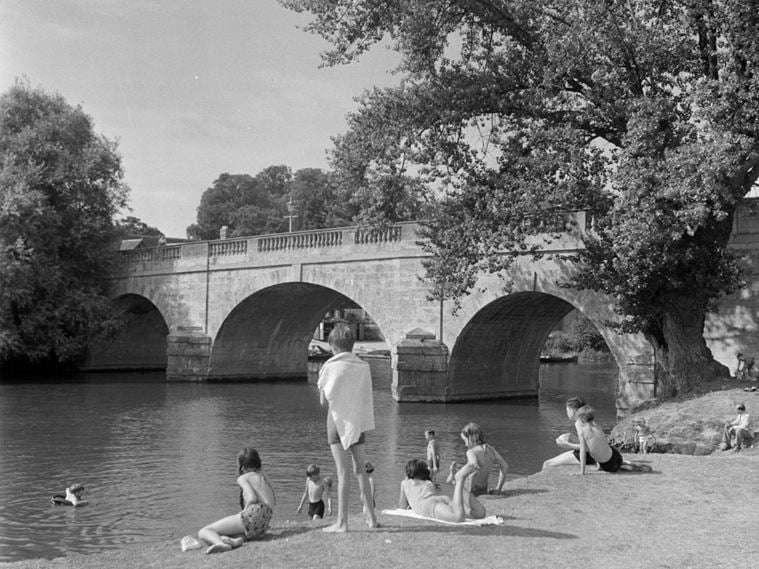
South Oxfordshire
Local Authority District